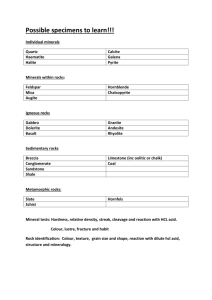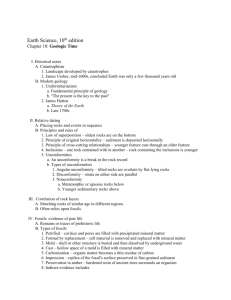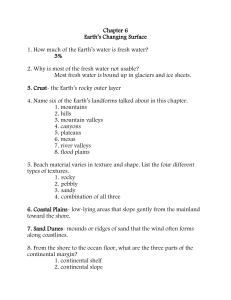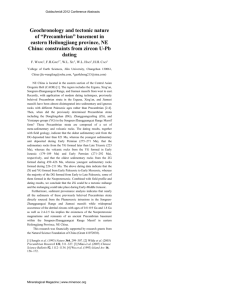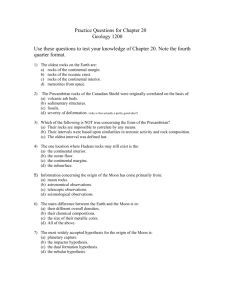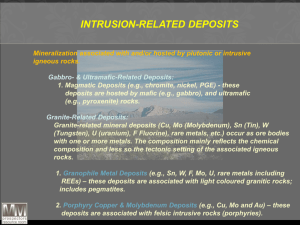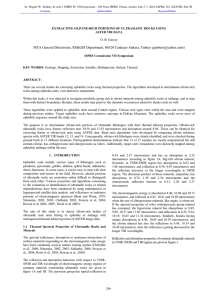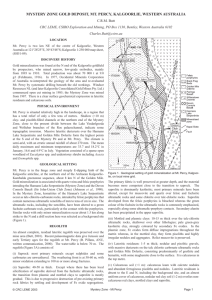deposited continental
advertisement
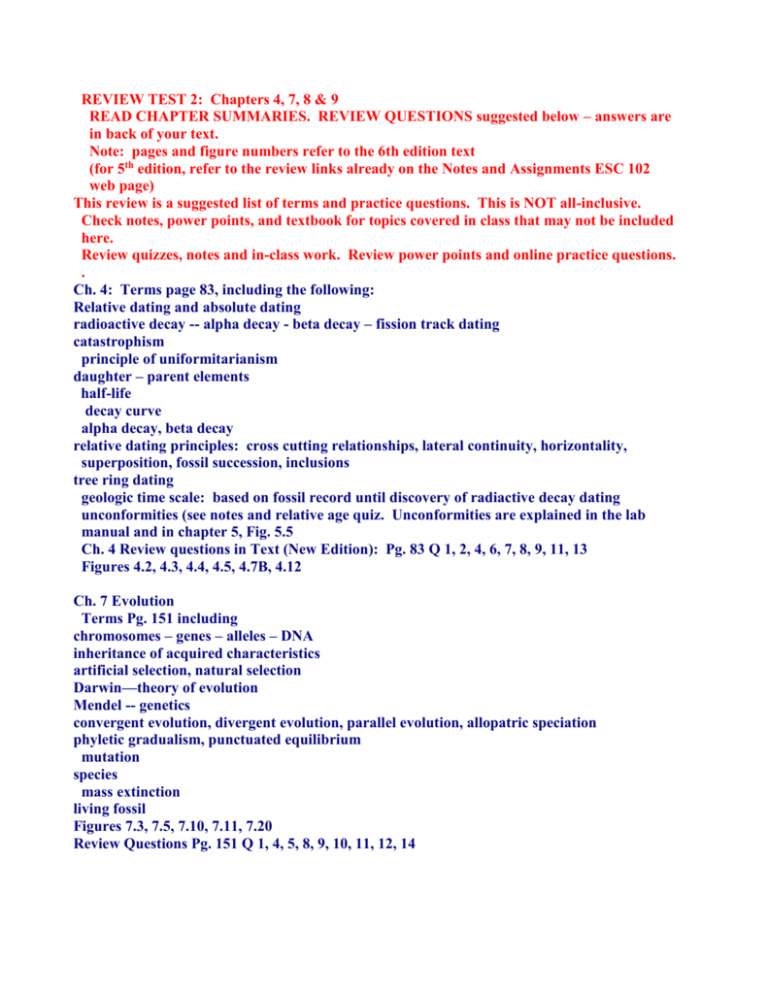
REVIEW TEST 2: Chapters 4, 7, 8 & 9 READ CHAPTER SUMMARIES. REVIEW QUESTIONS suggested below – answers are in back of your text. Note: pages and figure numbers refer to the 6th edition text (for 5th edition, refer to the review links already on the Notes and Assignments ESC 102 web page) This review is a suggested list of terms and practice questions. This is NOT all-inclusive. Check notes, power points, and textbook for topics covered in class that may not be included here. Review quizzes, notes and in-class work. Review power points and online practice questions. . Ch. 4: Terms page 83, including the following: Relative dating and absolute dating radioactive decay -- alpha decay - beta decay – fission track dating catastrophism principle of uniformitarianism daughter – parent elements half-life decay curve alpha decay, beta decay relative dating principles: cross cutting relationships, lateral continuity, horizontality, superposition, fossil succession, inclusions tree ring dating geologic time scale: based on fossil record until discovery of radiactive decay dating unconformities (see notes and relative age quiz. Unconformities are explained in the lab manual and in chapter 5, Fig. 5.5 Ch. 4 Review questions in Text (New Edition): Pg. 83 Q 1, 2, 4, 6, 7, 8, 9, 11, 13 Figures 4.2, 4.3, 4.4, 4.5, 4.7B, 4.12 Ch. 7 Evolution Terms Pg. 151 including chromosomes – genes – alleles – DNA inheritance of acquired characteristics artificial selection, natural selection Darwin—theory of evolution Mendel -- genetics convergent evolution, divergent evolution, parallel evolution, allopatric speciation phyletic gradualism, punctuated equilibrium mutation species mass extinction living fossil Figures 7.3, 7.5, 7.10, 7.11, 7.20 Review Questions Pg. 151 Q 1, 4, 5, 8, 9, 10, 11, 12, 14 Chapter 8 Pg. 170 TERMS: Archean, Eoarchean, aerobic, anaerobic, back arc marginal basin, black smokers, chemosynthesis, Precambrian Shield, Canadian Shield, craton, shield, platform, continental accretion, prokaryotic cells, autotrophic, heterotrophic, granite-gneiss complexes, greenstone belts, graywacke, ultramific rocks, pillow lavas, mafic rocks, partial melting, magnetosphere, outgassing, photochemical dissociation, photosynthesis, monomers, polymers, protobionts, proteinoids, radiogenic heat, differentiation of Earth, period of heavy bombardment, stromatolites, zircons (minerals from igneous rocks), characteristics of life, RNA, DNA Figures 8.1, 8.3, 8.4, 8.5, 8.6, 8.8, 8.9, 8.10, 8.11, 8.12, 8.13, 8.14, 8.15, 8.16, 8.19, Review Questions Page 171: Q 1, 2, 3, 4, 5, 7, 8, 9, 10, 13, Review of concepts: Precambrian time: 88% of entire earth history Eoarchean - first .6 billion years very little record except for rocks (i.e. Acasta gneiss 3.96by and Australian zircons ~4 by early earth: dim sun, closer moon, fast rotation (10 hour day) ,period of heavy bombardment, heated surface, differentiation taking place (layering of earth's interior), no free oxygen, probably thick atmosphere helped moderate and warm earth surface high amount of radiogenic heat from radioactive decay inside earth. faster plate movement, ultramafic rocks very low in silica. Proposed origin of continental type crust (called "sialic" composition with more silica and aluminum) as plates collided, ultramafic rock remelted partially to form basalt; then basalt remelted partially to form andesitic crust (intermediate composition) which is more continental in nature and prevented the growing continental crust from subduction (it was less dense). continental accretion was taking place at a fast rate. Every one of the continents has a precambrian "root" made of rocks that are either granite/gneiss complexes (most common) or greenstone belts. (see below) The precambrian or oldest rocks within a continent where exposed are called a "shield". where buried, they are called a "platform". The entire ancient root of a continent including exposed and buried rocks is referred to as a craton. Craton contains both shield and platform. Accretion of small “continents” (volcanic island arcs) by tectonics – deformation belts. Evidence: granite=gneiss complexes of Archean age. Greenstone belts: three layers: bottom ultramafic, middle basalts, top sedimentary *ultramafic: peridotite (mantle composition) – pillow lavas or basalts prove underwater formation by underwater lava flows. NOTE: ultramafic rocks do NOT form today as earth has cooled and can no longer melt and crystallize these high temperature rocks *mafic – basalt – these are more EVOLVED – meaning they probably formed from partial melting of ultramafic material. *sedimentary – these represent eroded pieces of continents that were deposited near continental margins, probably at or below sea level. graywacke is the dark colored sandstone that contains clay – eroded from mafic continental crust. sedimentary rocks are found to be forming a syncline (low areas, like a basin, sinking) cross bedding – these are patterns of sediments that are formed when deposited by moving water. graded beds: when turbulant waters move sediments down a slope , graded beds form. the coarser sediments drop out first, then medium, then fine on top. THESE ARE FORMED BY TURBIDITY CURRENTS. when the current repeats, a new deposit forms on top of the old – with coarse, medium then fine. Concept questions: Understand how the Earth’s magnetosphere formed. How did Earth’s magnetic field affect the early atmosphere? Understand Stanley Miller’s experiment and how it relates to ideas about the origin of life. Describe the significance of the Archean-age fossil stromatolite structures? What does the existence of the organisms imply? What important effect did stromatolite-forming organisms have on the atmosphere? Review Chapter 9 Proterozoic Terms: banded iron formation, continental red beds, endosymbiosis, eukaryotic cells, Laurentia, Midcontinent rift, orogen, Wopmay Orogeny, Wilson cycle, rifting, sandstone-carbonate-shale assemblages, Ediacaran fossils Grenville Orogeny, supercontinents (Rodinia, Pannotia) Figures: 9.2, 9.3, 9.6, 9.9, 9.10, 9.11, 9.13, 9.17, 9.19 Review Questions from Text: (answers pg. 430) 1, 2, 3, 4, 5, 7, 8, 9, 10, 12, 14, 17, 18, 19


